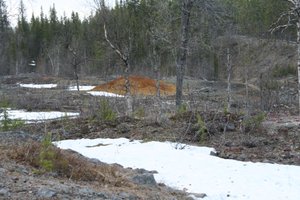Fences, Insects, Embroideries (material communities)
The exhibition is part of WIENWOCHE 2022 and corresponds to the research project ‘Two Ore Mountains: Feminist Ecologies of Spatial Practices’, by Karin Reisinger, Academy of Fine Arts Vienna.
Who provides the labour in order for this text to be written on a laptop, for data to flow, for our flats to be heated, and for our monuments, houses and industries to be built (or destroyed)?
The global network of supply chains of materials and energy has to be reshuffled in the face of the continuous vulnerabilities and atrocities that it causes. Zooming in while also exploring global connections, the exhibition takes a closer look at the complex entanglements of exploitation.
WHO DOES THE WORK?
For some, extractive labour is the only way to survive, especially and paradoxically for those workers whose environments are being destroyed in the process. Amid contemporary racisms and sexisms and their toxic actualizations, how can ‘we’ consider more-than-human labour?
Without the agencies of water, rocks, bees, trees and birds, nothing remains to be done. Humans carry stones, but stones carry weight. Which stones, whose stones, and moved by whom? And in whose lungs do they arrive as a sedimentation of the dust, mingled with saliva? Birds, insects and trees do the labor of reforestation on dug up and disturbed ground. How will the more-than-human communities come together in exploited territories?
WHO BELONGS TO THE COMMUNITY?
Following the material, following the followers of the material and staying with their troubles for a while can lead to surprising naturecultures. (Unpaid) care, love and the enormous work of radical endurance amid exploited areas. Embroideries document the lost homes, and their shared production allows for a coming together and exchanging of stories of sorrow and joy. Paintings report lost environments. Testaments of radical endurance and pleasure emerge in unexpected places, together with the precarious labour of healing.
Relating to destroyed and damaged worlds, this exhibition looks at how material is exploited, moved, crushed, chopped and utilized – to extract yet further material. It opens up a space for thinking and sharing ways of responding to the complex ecologies of the more-than-human communities of lithic labour, which constantly reorganize in environments stripped for the benefits of those living far away, namely, here.
Exhibition contributors: Rehema Chachage, Lisa Hinterreithner, Karin Hojak-Talaber, Sepideh Karami, Dariia Kuzmych, Sara Lanner, Ernst Logar, Malmnedles / Handarbetscafé Gällviare-Malmberget, Katarina Pirak Sikku, Alexander Rynéus & Per Bifrost, Asha Sumra, Miriam Vikman
Curated and organized by Karin Reisinger
Production support: Mo Hartmann, Halina Rahdjian, Ilvy Reisinger
List of entries
-
–
On Dealing with Loss
Embroidery workshop (EN) with Handarbetscafé Gällivare-Malmberget (Karina Jarrett and Eeva Linder) in the framework of the exhibition Fences, Insects, Embroideries (material communities) (WienWoche)
Workshop
–
Geologische Bundesanstalt
Neulinggasse 38
1030 ViennaEducation in the Arts
-
Fences, Insects, Embroideries (material communities)
Exhibition opening with Handarbetscafé Gällivare-Malmberget (Karina Jarrett and Eeva Linder)
Welcome: Geologische Bundesanstalt (Robert Supper, Holger Paulick, Thomas Hofmann) and Swedish Embassy (EN)Opening and Workshop
Geologische Bundesanstalt
Neulinggasse 38
1030 ViennaEducation in the Arts

-
–
On Living in Extractive Areas
Workshop (EN) with Katarina Pirak Sikku and Miriam Vikman in the framework of the exhibition Fences, Insects, Embroideries (material communities) (WienWoche)
Workshop
–
Geologische Bundesanstalt
Neulinggasse 38
1030 ViennaEducation in the Arts
-
–
Performances
In the Framework of Fences, Insects, Embroideries (material communities) (WienWoche)
Performances
–
Geologische Bundesanstalt
Neulinggasse 38
1030 ViennaEducation in the Arts
